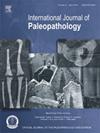Insights into the anatomical expressions of anencephaly in three infants from 17th to 19th- century Lisbon, Portugal
IF 1.5
3区 地球科学
Q3 PALEONTOLOGY
引用次数: 0
Abstract
Objective
This study aims to analyse and compare the cranial morphological variations in three individuals, each exhibiting different severity levels of malformations.
Materials
Three nearly complete and well-preserved skeletons of infants from the São Domingos children's necropolis in Lisbon, Portugal, dating from the 17th to early 19th centuries.
Methods
Macroscopic and metric assessments were performed aimed at creating a detailed description of the skeletons.
Results
The three infants exhibit an absence of the upper cranial vault, accompanied by several cranial bone alterations such as abnormal development and morphology of the occipital, sphenoid, temporal, and frontal bones. Additionally, two of the infants present maxillary and dental anomalies.
Conclusions
The three infants from the São Domingos necropolis provide crucial insights into the presence of anencephaly in an historical population, representing an exceptionally rare archaeological find. The distinct cranial abnormalities strongly support the diagnosis and highlight varying severity levels of the condition.
Significance
These examples enhance the recognition of anencephaly in archaeological contexts and deepen the understanding of its varied bone expressions. Examining skeletal variations within the same condition also complements the broader palaeopathological discussion of rare diseases.
Limitations
The lack of soft tissue preservation reduces a comprehensive assessment of anencephaly in skeletal remains. The archaeological context presents challenges such as fragmentation. Additionally, determining postnatal survival is difficult due to the subtle or absent skeletal indicators that might suggest survival beyond birth.
Suggestions for further research
Biomolecular genetics analysis could be a valuable approach for future research.
17至19世纪葡萄牙里斯本三个无脑畸形婴儿的解剖表现
目的分析和比较3例不同程度畸形患者的颅形态差异。葡萄牙里斯本多明戈斯儿童墓地出土的三具几乎完整且保存完好的婴儿骨骼,可追溯到17世纪至19世纪初。方法进行宏观和度量评估,以建立骨骼的详细描述。结果3例患儿均表现为上颅穹窿缺失,伴有枕骨、蝶骨、颞骨和额骨发育和形态异常等颅骨改变。此外,两名婴儿出现上颌和牙齿异常。结论:来自多明戈斯墓地的三名婴儿为研究历史上无脑儿的存在提供了至关重要的见解,这是一个极其罕见的考古发现。明显的颅骨异常有力地支持了诊断,并突出了病情的不同严重程度。这些例子增强了对考古背景下无脑畸形的认识,加深了对其不同骨骼表达的理解。在相同条件下检查骨骼变异也补充了对罕见疾病的更广泛的古病理学讨论。局限性:软组织保存的缺乏降低了对骨骼残骸中无脑畸形的全面评估。考古背景提出了诸如碎片化等挑战。此外,由于骨骼指标的微妙或缺失可能表明出生后存活,因此确定出生后存活是困难的。生物分子遗传学分析是一种有价值的研究方法。
本文章由计算机程序翻译,如有差异,请以英文原文为准。
求助全文
约1分钟内获得全文
求助全文
来源期刊

International Journal of Paleopathology
PALEONTOLOGY-PATHOLOGY
CiteScore
2.90
自引率
25.00%
发文量
43
期刊介绍:
Paleopathology is the study and application of methods and techniques for investigating diseases and related conditions from skeletal and soft tissue remains. The International Journal of Paleopathology (IJPP) will publish original and significant articles on human and animal (including hominids) disease, based upon the study of physical remains, including osseous, dental, and preserved soft tissues at a range of methodological levels, from direct observation to molecular, chemical, histological and radiographic analysis. Discussion of ways in which these methods can be applied to the reconstruction of health, disease and life histories in the past is central to the discipline, so the journal would also encourage papers covering interpretive and theoretical issues, and those that place the study of disease at the centre of a bioarchaeological or biocultural approach. Papers dealing with historical evidence relating to disease in the past (rather than history of medicine) will also be published. The journal will also accept significant studies that applied previously developed techniques to new materials, setting the research in the context of current debates on past human and animal health.
 求助内容:
求助内容: 应助结果提醒方式:
应助结果提醒方式:


